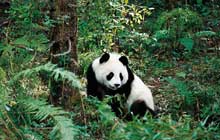
 The cuddliest, cutest, best-behaved pet you could want for your bamboo garden? Whatever you end up thinking of this most peculiar creature, it is impossible to take your eyes off them, and the place to explore questions surrounding this dichromatic bear of bears is the Panda Research and Breeding Centre in Chengdu .
The cuddliest, cutest, best-behaved pet you could want for your bamboo garden? Whatever you end up thinking of this most peculiar creature, it is impossible to take your eyes off them, and the place to explore questions surrounding this dichromatic bear of bears is the Panda Research and Breeding Centre in Chengdu .
The panda is a native of the mountain forests in Sichuan , with some territory overlapping into the neighboring Gansu and Shaanxi Provinces . There are only a little over one thousand left in the wild, and over eighty percent of them are in Sichuan . Most of them are to be found in the mountain forests at the edge of the Tibetan Plateau. The government has taken a number of administrative steps to protect the pandas: they have introduced legislation against further logging in the habitat areas and have brought those areas under conservation orders. Despite this good work there are substantial worries about the long-term survival of the bears if left to their own devices; while there are around thirty distinct populations in the wild the majority of those populations have less than fifty individuals, not a high enough number to ensure survival. Partly to offset that lack of numbers this large institution on the outskirts of Chengdu was set up with the aim of increasing panda reproduction, and then training the young so that they can be released back into the wild. It is hoped that greater numbers and less fragmentation will eventually guarantee the species a future. However, the reproductive habits of the panda make this task much more difficult than it may appear. Female pandas only ovulate once a year, in the spring. This short period of two to three days is the only time she can conceive. She will give birth somewhere between three and seven months later. Births are usually single, and even when two cubs appear more often than not only one will survive. Because the panda young stay with their mother for a minimum of two years this generally means she can breed at most only every second year. With a life expectancy around thirty and a sexually active period of up to fifteen years it is easy to see why the population will take a long time to recover from any setbacks it suffers.
The institute covers a large area mostly of bamboo forests and a lake, and the animals here seem to like where they are. In the grounds you can often see both adults and young of the giant panda; the red panda and some water birds can also be found on the grounds. If you can take your eyes off the main attraction, the bamboo groves make for a pleasant stroll, especially if you've not experienced them before.
But the headline attraction cannot be anything but the giant pandas. They strip, shred, and eat bamboo with gusto; the young ones play in the trees and climb out on branches where they always elicit "oohs" and "aahs" from their rapt audience by balancing awkwardly from branches that seem to light to hold them. There aren't many places in the Chinese world where animals are so well on show.